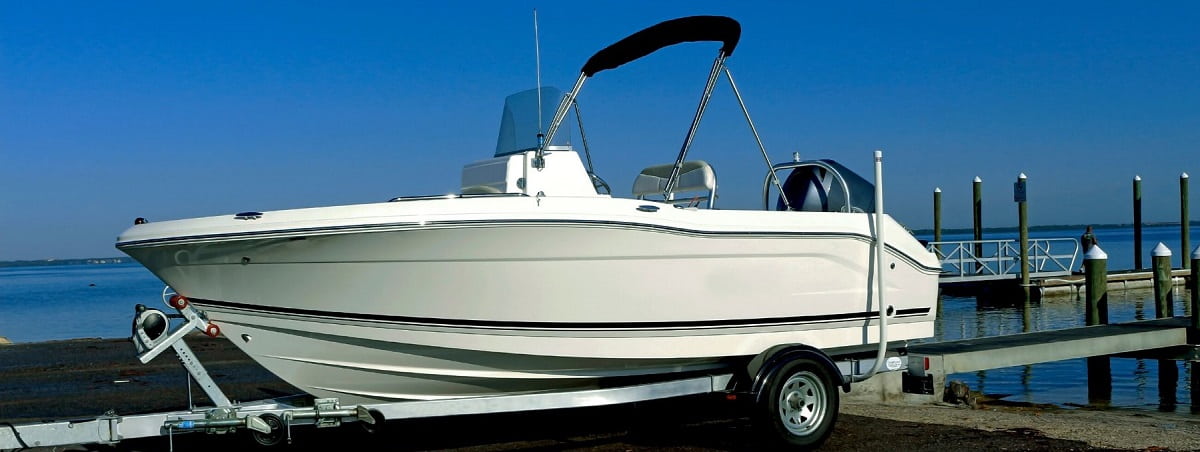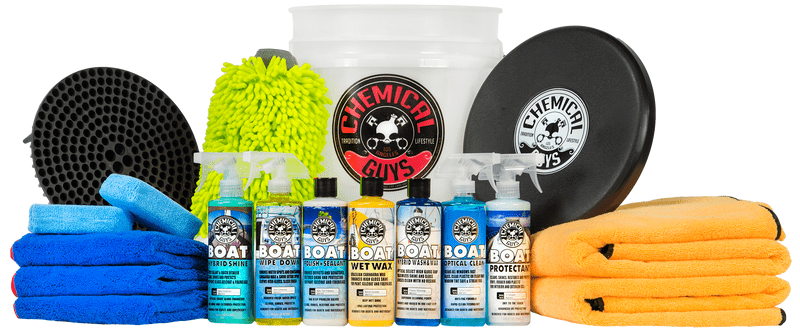
Ultimate Boat Detailing Checklist
After a while, your boat will more than likely begin to look a somehow dirty as dirt particles from the air and contaminants from the water collect on the boat’s surface and the interior. When this occurs, it’s time to detail your boat to bring back its former look.
Boat detailing can be a tough job since you have to consider environmental factors such as water (freshwater or saltwater), wind, and other weather elements in the care, protection, and cleaning of your vessel.
In this guide, you’ll learn each of the steps required to take in order to get your boat in tip-top condition, bit for the best results you need to hire professional boat detailer.

#1 Boat Detailing San Diego
Purpose
It’s a process that includes refurbishing the exposed surfaces of the boat to improve their appearance. The operation may involve cleaning, waxing, sanding, polishing, and painting various areas of the vessel. The actions performed during this procedure are varied since vessel surfaces are made from different materials such as fiberglass, gel coats, stainless steel, canvas, and mahogany wood. The result of this process is that the surfaces are clean, smoothed, and refurbished with a new and appealing look.
What Are the Benefits?
Not only does detailing improves the appearance of the boat, but it also extends its usable life. When vessels are exposed to saline environments and UV radiation, the furnishing on the surface starts to fade and wear off over time. Metal components and surfaces can corrode also, and it’ll affect their performance. With this operation, the surfaces are refurbished, and this enhances their resilience to the harsh environments.
How to Detail a Boat?
Conducting these simple steps can make detailing boats faster and easier.

Step 1: Rinsing
Use a spray of clean water to remove any grime or loose debris from the surface. Go from the top of your boat and work your way down until you reach the bottom. This’s just to remove the loose bits that are on the surface of the boat, this won’t give it a complete clean.
Step 2: Soaping
Once you’ve removed the loose pieces of grimes and debris, it’s time to get to work on the more stubborn dirt on the exterior surface. Using a specialized boat cleaner, get to work lathering the outside of the boat to agitate the grime. It would help if you never let the soap dry onto the boat surface as you risk damaging the finish and leaving horrible streaks.
You should soap small spots at a time, rinsing the soap off as you go before moving onto the next area. You’ll be applying protective treatments later, but the quality of that protection depends on how good your cleaning preparation in advance is.
Step 3: Waxing
Utilizing a wax that’s similar to the brand of cleaner you applied, rub a boat with a considerable amount of pressure, ensuring that you evenly spread it. As you do this, you should see a small change of color as you put the wax. Do a little at a time and then remove it after a short time to dry. If you’re working in hot conditions, you’ll need to remove the wax sooner than usual.
Step 4: Interior cleaning
Exterior detailing is only the first part of the operation. You still have to address the interior. Use a cleaner that will work on multiple surfaces. The cleaner that you pick should do an excellent job of cutting through grime and dirt but mild enough that it doesn’t damage any of the interior areas. Any metal fixtures in an interior can be cleaned and reconditioned utilizing metal polish. To keep metal surfaces glossy, consider adding a coat of wax to them, as well.
Step 5: Finishing
After cleaning and waxing the boat, you want to keep it looking its best for as long as possible. Keeping the like-new look of a freshly detailed boat is easy when you have the right products.
Apply protectants to any boat areas that will be exposed to the sun. For example, plastic, rubber, and vinyl surfaces should be coated with an aerospace protectant. Gel coat surfaces can be cleaned up with a speed detailer. You should also apply a special protectant on fabric surfaces to safeguard them from mold, mildew, and moisture.
Boat Detailing Products
The proper tools will make detailing a boat easier, quicker, and more productive. By using the right supplies, you’ll get the best results from boat and RV detailing products.
Brands like Meguiar’s, 3M, and DeWalt all have detailing kits, which offer various collections of products/supplies. These could include everything from cleaners to chamois cloths, buffers, brushes, and more.

Here’s a list of what should be in your working kit:
- Microfiber towels and/or chamois cloths;
- Brushes and applicators for various surfaces and cleaning needs;
- Mops and sponges;
- Waxing and polishing tools or cloths;
- A blower or vacuum for carpets or debris removal;
- Degreasers and cleaners;
- Waxes and polishes;
- Gel coat protectant (fiberglass boats);
- Stain removers;
- Water spot removers or power washers (optional).
Boat Detailing Tips and Procedures
The following tips and procedures will help preserve your boat’s good look and protect your valuable recreational asset from the harsh marine environment.
- Cover boat for long-term storage, preferably with shrink-wrap, which provides better protection, lessens chafe and keeps the boat appreciably cleaner;
- Before using any product, read the application and first aid instructions on the back label and then follow them;
- When detailing a boat in a mooring or a slip, use a biodegradable, environmentally friendly soap;
- Begin rinsing and cleaning at the highest point and work your way down;
- When cleaning a filthy boat, use a second large bucket filled with clean water to rinse the wash mitt or brush often to remove grime and dirt;
- Reduce soapsuds so you can see what you’re cleaning;
- For the final rinse, remove the hose nozzle and minimize the water pressure so water sheets rather than beads on the surface;
- Dry surfaces after rain or heavy dew;
- Strenuously shake product bottles for a few seconds before opening;
- Apply rubbing compounds in a back-and-forth motion. Add polish or wax in a circular motion;
- Apply polish to everything onboard, including painted finishes, metals, and plastics, for a shiny, easy-to-clean protective layer.
Saltwater Protection
If you’re sailing in saltwater, you need to have proper saltwater protection. The biggest difference in freshwater and saltwater sailing is the speed with which you have to rinse your vessel clean after an excursion. It would be best if you always rinsed the boat after a saltwater excursion to eliminate excess residue that can lead to corrosion or damage. Also, you should flush the engine with fresh water to ensure no salt residue stays inside the compartments, to avoid rust and other damage.
Sealants vs. Wax
Sealants and waxes are formulated to protect the boat’s finish from salt, grime, UV rays, and so on. Sealants are abrasive but are easier to use. They fill the pores in the gel coat and dry to a hard finish that lasts the entire season. It’s crucial, however, to choose a sealant made for gel coat finishes. It should include a polishing or micro cleaning agent and not be abrasive. Don’t use a car sealant that doesn’t explicitly say it can be used for gel coat surfaces.

Boat Detailing Prices
Boat detailing cost varies from place to place. This’s largely thanks to the demand for the service as well as the prices of supplies. Therefore, most services will do pricing, relying on size. To get the exact price for your vessel, it’s best to get an estimate from a few shops and choose from there.
On average, a professional detailer is going to charge anywhere from $10 to as much as $40 per foot, depending on boat detailing services, the boat’s size, and the condition. The bigger the boat is, the more it’ll cost.
How Often Should I Detail a Boat?
If possible, at least rinse and dry a boat after each outing, especially if you’re in saltwater and keep the vessel on a trailer. You don’t need to use soap each time – in fact, that could break down any wax you applied. A wax job should last three to six months, and a high-quality paint sealant could protect the boat for a season. The other cleaning operations can be done on an as-needed basis.
How Long Does a Boat Detailing Usually Take?
Of course, not all boats come in the same size. Regardless of this, it’s also a fact that they usually come in much larger sizes than your mid-sized vehicle. If it takes a few hours to detail a car, it’s safe to say that it will take much longer. Therefore, it’s better to schedule your appointment long before you have to set sail.
Mobile Boat Detailing San Diego Expert
We provide the most exceptional detailing service with the added convenience of mobile service personnel that will come to your home or any other place to detail your boat and RV. Since we care about your boat or RV as much as you do, our boat detailers use the finest product line in marine care and cleaning.
Call us today for more information about the best San Diego Detailing services.